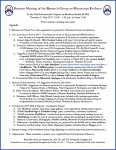2020 International Congress on Medieval Studies Program Announced
January 18, 2020 in Abstracts of Conference Papers, Announcements, Bembino, Conference, Conference Announcement, Index of Christian Art, Index of Medieval Art, International Congress on Medieval Studies, Kalamazoo, Societas Magica
Research Group on Manuscript Evidence
at the 55th International Congress on Medieval Studies
7–10 May 2020
Program Announced
[NOW CANCELLED OR POSTPONED]
[Update on 12 July 2020: Now see 2021 International Congress on Medieval Studies Call for Papers]
[Published on 18 January 2020, with updates.
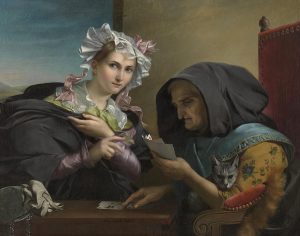
Adèle Kindt (1804–1884), The Fortune Teller (circa 1835). Antwerp, Koninklijk Museum voor Schone Kunsten. Image via Wikimedia Commons.
Update on 17 March. The 55th Congress has been Cancelled.
According to the website for the International Congress on Medieval Studies:
The health and safety of our attendees and our community are our first priority. Due to the COVID-19 outbreak and the most recent recommendations of the CDC and the WHO regarding social distancing and public gatherings, we have made the difficult decision to cancel the 55th International Congress on Medieval Studies (May 7-10, 2020).
As for the future, according to the Congress organizers:
We invite the organizers of sponsored and special sessions approved for the 2020 Congress to re-propose them for the 2021 congress. If proposed, they will be approved automatically.
Meanwhile, with the preparations for the Congress set aside, the Research Group on Manuscript Evidence continues to advance with posting the Abstracts of the intended Papers for our 2020 ICMS Sessions, to stand alongside their Statements of Purpose as designed for the Call for Papers and announced in this post.
Our tradition regularly has been to post on our website the Abstracts before our Sessions in a given Congress, as a foretaste of the Menu. Years ago, as a sign of appreciation, we adopted the custom of posting the Abstract of one or other contributor who became unable to attend to present in person (as with the 2016 Congress and the 2014 Congress). Thus we honor the intentions of our participants to present the results (or interim results) of their research and reflections, even when they could not do so at the event.
Before March 2020, only once before, in more than 30 years of activities in many centers in the United States and elsewhere (see our Events and Congress Activities), has the Research Group had to cancel an event itself. That case was only 1 Session among 7 sponsored and co-sponsored Sessions at the 48th International Congress on Medieval Studies in May 2013.
This March, in stark contrast, 2 of our major events for 2020 have had to be cancelled as a whole. This change pertains both at the Congress and elsewhere. First, our 2020 Spring Symposium, From Cover to Cover, intended for 13–14 March at Princeton University, has been Cancelled or Postponed. Now, the 55th ICMS intended for May at Kalamazoo.
For the former, we aim to complete the Symposium Booklet, with the Program, Abstracts, and Illustrations, as planned,and distribute it to contributors, registrants, and others, as a souvenir of the collective aims for the gathering. Here we similarly honor our participants’ intentions by recording their Abstracts.]
*****
What We Planned
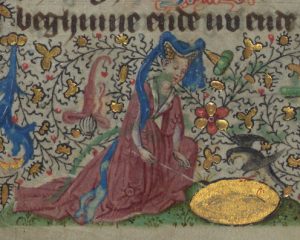
Baltimore, The Walters Art Museum, MS W.782, folio 15r. Van Alphen Hours. Image via Creative Commons.
With the achievement of our Activities at the 2019 International Congress on Medieval Studies (ICMS), described in our 2019 Congress Report, we prepare for the 2020 Congress. With the conclusion of the Call for Papers on 15 September 2019 for our sponsored and co-sponsored Sessions, we have assigned their Programs and reported them to the Congress Committee.
Now, as the new year begins, we announce the programs as well as our other activities at the 2020 Congress. As the Congress announces its Sneak Preview of the 2020 Congress Program, we report the times and room assignments. Soon, as is our custom, we will publish the Abstracts for their Papers and Responses.
*****
Our events at the Congress, as always, are designed to represent, to explore, to promote, to celebrate, and to advance aspects of our shared range of interests, fields of study, subject matter, and collaboration between younger and established scholars, teachers, and others, in multiple centers.
This year, the response to the Call for Papers for our Session on Seals received so strong a response that we have been granted 2 sessions in the place of the one as accepted. Again this year we co-sponsor Sessions with the Societas Magica (2 Sessions this year). It will be the 16th year of this co-sponsorship.
Also, like the 2015–2019 Congresses, we plan for
- an Open Business Meeting and
- a co-sponsored Reception.
Again, like the 2016–2018 Congresses, we co-sponsor a Reception with the Index of Medieval Art at Princeton University (formerly the Index of Christian Art).
Abstracts for previous Congresses appear in our Congress Abstracts, Indexed both by Year and by Author. The Abstracts for this year’s Congress will join their company.
Background and Foreground
Glimpses of our co-sponsored Receptions at the Congress appear in the souvenirs of our Celebrations and in the Reports for the individual Congresses (2016, 2015, and 2014 Anniversary).
The Agendas for our Open Business Meetings are available for your inspection and perusal:
These 1-page statements serve as concise Reports for our Activities, Plans, and Desiderata. Some of these Agendas now stand among the Top 5 Most Popular Downloads on our site.
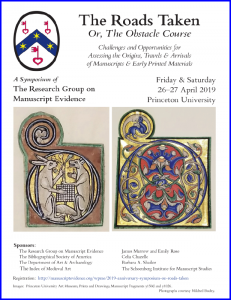 The most popular downloads still remain our copyright and FREE multilingual digital font Bembino, and some Booklets from our Symposia and Colloquia. So far, those “best sellers” — they are FREE — include:
The most popular downloads still remain our copyright and FREE multilingual digital font Bembino, and some Booklets from our Symposia and Colloquia. So far, those “best sellers” — they are FREE — include:
- The Roads Taken (2019 Anniversary Symposium)
- Words & Deeds (2016 Symposium)
- When the Dust Has Settled (2014 Colloquium)
- Crusading and the Byzantine Legacy and The Medieval Balkans as Mirror (two of our 2016 Congress Sessions)
- Predicting the Past (one of our 2015 Congress Sessions).
These publications, like most of our Publications, are FREE, but we welcome donations, both in funds and in kind, for our nonprofit mission, with the option of tax-deduction for your Donations.
We look forward to your contributions.
*****
Events for the 2020 Congress [ALL NOW CANCELLED]
In addition to its Sessions of Papers, the Research Group on Manuscript Evidence holds its Annual Business Meeting and co-hosts a celebratory Reception. All are welcome.
Open Business Meeting [CANCELLED]
Thursday, 7 May
12:00–1:00 p.m. with lunch provided
Fetzer 1035
 Reception co-sponsored with the Index of Medieval Art [CANCELLED]
Reception co-sponsored with the Index of Medieval Art [CANCELLED]
Friday, 8 May
5:30–7:30 p.m. with hosted bar
Bernhard G10
Sessions for the 2020 Congress
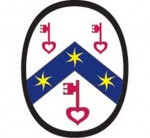 I. Sponsored by the Research Group on Manuscript Evidence
I. Sponsored by the Research Group on Manuscript Evidence
3 Sessions
1–2. Seal the Real: Documentary Records, Seals & Authentications, Parts I & II
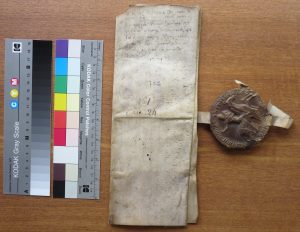
Judgment of Arbitration by Philip I, Count of Savoy, of 28 May 1275
with Brown Wax Seal
and with Docketing in French. Photograph by Mildred Budny.
[Update: The responses to the Call for Papers for this single session (as we proposed) now allow us, with Congress permission, to have 2 sessions, in 2 parts.
Further Update: Now CANCELLED, but we publish the Abstracts nonetheless.]
These session explore the presentation and attestation of documentary records in the medieval and early modern periods, in the long transition to the modern custom of signatures as autographs — as distinct (partly) from earlier ‘signatures’ often made by proxy, whether by cross-signs, names inscribed by others on behalf of the signatory, personal or official seals, or other forms. The fields of consideration include forgeries (‘signatures’, seals, and questionable documents), reported records of documents perhaps otherwise lost (as in cartularies, chronicles, and other narratives), and the occasional preservation of fingerprints upon the records themselves.
The time-honored human determination to establish recognized — that is, effective — modes of authenticating intentions and actions by individuals and institutions alike underpins the historical transmission (or disruption, willful and otherwise) of formal records of agreements, sales, transfers, decisions over grievances and feuds, and other impactful official arrangements across the centuries. Examining case studies for this session, we encourage multiple approaches, subject matters, and methodologies for analyzing the strategies adopted (successfully or otherwise) in the pursuit of such a quest for authentication.
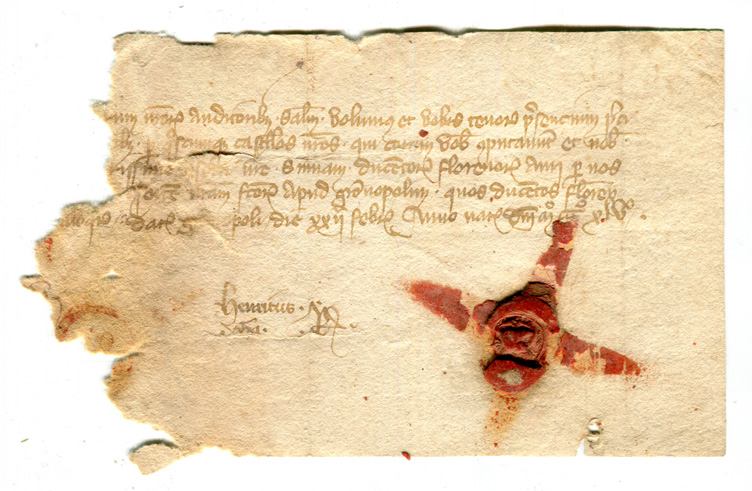
Document in 5 lines on paper, dated 22 February 1345 (Old Style), from Toulouse, with red wax seal.
The desire effectively to express identity and authenticity as a matter of record may well resonate with many participants. The Session considers aspects of the historical traditions, improvisations, inventions, and (it may be) occasional failures of earlier centuries in such a quest. Perchance we might learn instructively from the past.
Organizer
Mildred Budny (Research Group on Manuscript Evidence)
Part I: Signed & Sealed [CANCELLED]
Thursday, 7 May
Session 115: 10:00–11:30 a.m.
Fetzer 2040
Presider
Mildred Budny
Presenters
Laura J. Whatley (Fine Arts Department, Auburn University — Montgomery)
“Sealing the Historical Record in Matthew Paris’s Chronica Maiora”
John McEwan (Center for Medieval and Renaissance Studies, Saint Louis University)
“Antiquity Revisited: Ancient Gems in Medieval English Seals”
James Eric Ensley (English Department, Yale University)
“Signed, Sealed, Delivered? Hoccleve’s Ambiguous Seal Poetics”
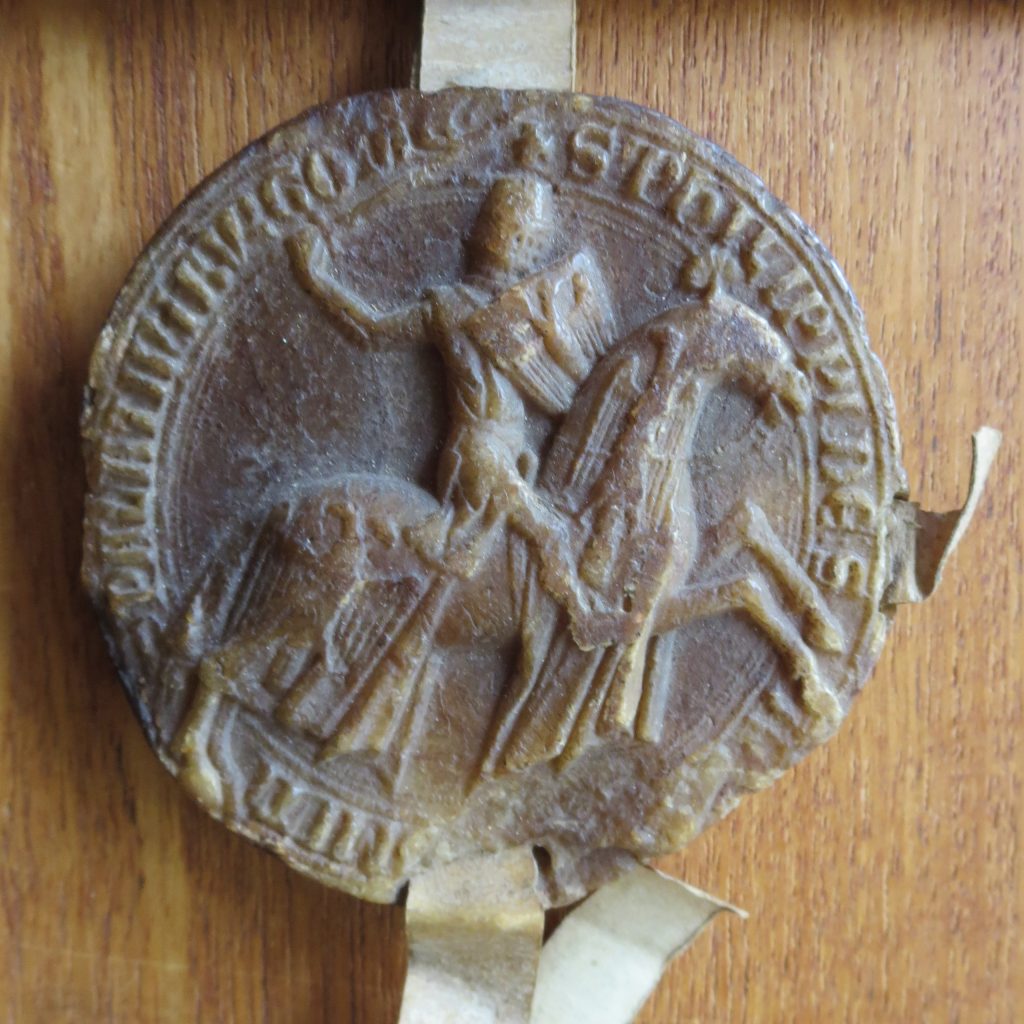
Equestrian Wax Seal of Philip I, Count of Savoy,
Affixed to his Judgment of Abritration, 28 May 1275. Photograph by Mildred Budny.
[Note that our Open Business Meeting takes place in between these 2 Sessions, in a nearby room in the same building.
12:00–1:00
Fetzer 1035
Lunch is provided, through a donation.]
Part II: × Marks the Spot [CANCELLED]
Thursday, 7 May
Session 115: 3:30–5:00 p.m.
Fetzer 2040
Presider
Derek Shank (Research Group on Manuscript Evidence)
Presenters
Michael F. Webb (Independent Scholar, Detroit, Michigan)
“By Our Own Hand: Cross-Signs in the Cartularies of Angoumois”
David W. Sorenson (Alan G. Berman, Numismatist)
“A Strange Seal from Grenoble from 1346, or Headbinding in France: Carryover and/or Forerunner in Toulouse?”
Respondent
Mildred Budny
“Seals, Matrices, and Signatures: A Response”

Seal on a Document from Toulouse of 13 February 1345 (Old Style).
3. Prologues in Medieval Texts of Magic, Astrology, and Prophecy [CANCELLED]
Friday, 8 May
Session 273: 3:30–5:00 p.m.
Bernhard 213
Although the prologues of learned books of magic could take many forms, nearly all share at least one common characteristic: the claim to transmit a secret and pristine branch of knowledge. Such claims are frequently couched in the form of a narrative describing how this secret knowledge was originally revealed. Many employ the same actors (Hermes Trismegistus, King Solomon, Aristotle), the same objects (a tablet or disk made of precious material and inscribed with divine wisdom), and the same locations (a hidden cavern or lost pagan temple). These narratives helped to establish the authority of their texts, broadcast their affiliation with specific discourses, and signal how they should be read. Moreover, the prologues served to highlight the erudition of their authors through the use of classical and biblical references and often sophisticated word-play.
The aim of this session is to explore these still largely understudied prologues which testify to the variety of medieval approaches to ‘magic’. What do these prologues have to tell us about the institutional, cultural, and political milieux in which they were produced? How do certain recurring mythemes found in these prologues stand in relation to the various magical and divinatory arts, specifically those classified as natural or demonic? And to which philosophical, mystical, or religious beliefs do they appeal in order to justify the magical practices that they introduce?
This session explores such questions, challenges, and potentials.
Other potential topics relating to magical prologues include, but are not limited to

Hermes Trismegistus holds an open book. Frontispiece Image (Lyons, 1669) via Wikimedia Commons and Wellcome Images (Wellcome_L0000980).
- the rhetoric of authority and the relation between power and secret knowledge
- the intersection of diverse intellectual traditions
- the continuity and reception of the Classical Tradition
- the appropriation of Jewish and Arabic traditions
- the relation between the tropes and mythemes found in magical prologues and those in other literary genres, such as prophecies and romances
- the assimilation of philosophical and medical texts
- the use of the Bible and biblical traditions
- philological and text-critical studies of magical prologues.
Organizer
Vajra Regan (Centre for Medieval Studies, University of Toronto)
Presider
David Porreca (Department of Classics, University of Waterloo)
Presenters
Magda Hayton (Religious Studies Department, Missouri State University)
“Pierre d’Ailly and the Oraculum angelicum Cyrilli”
Zachary Severs (Department of Romance Languages and Literatures, University of Michigan)
“Calming Turbid Waters and Skies: The Repurposing of Lucan’s Pharsalia and Cosmological Knowledge in Juan de Mena’s Laberinto de Fortuna”
Vajra Regan
” ‘Au lecteur’: Biblical and Occult References in Three Prologues from a Late Medieval Lapidary”
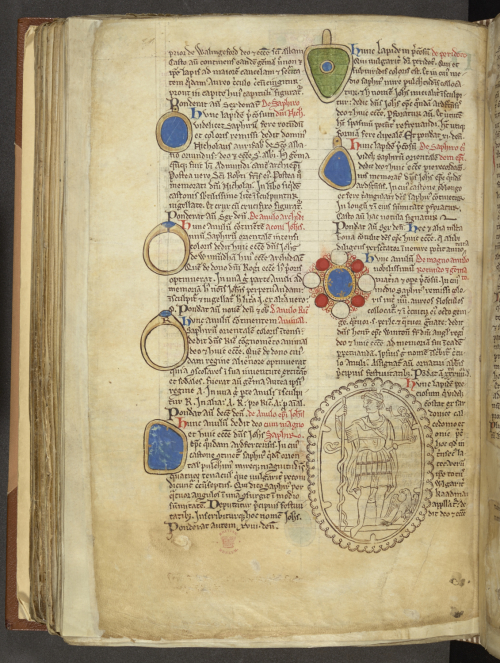
London, British Library, Cotton MS Nero D I, folio 146v. Matthew Paris’s description in the ‘Liber Additamentorum’ of the gems of Saint Albans Abbey.
II. Co-Sponsored with the Societas Magica
 2 Sessions, in Parts I & II: Revealing the Unknown
2 Sessions, in Parts I & II: Revealing the Unknown
4. Revealing the Unknown I:
Scryers and Scrying in the Middle Ages and Early Modern Period [CANCELLED]
Saturday, 9 May
Session 344: 10:00–11:30 a.m.
Fetzer 2030
From the little boy on the lap of the priest to the astrologer physician Richard Napier, scryers have fulfilled a significant role in spirit communications throughout the Middle Ages and early modern period. That children were instrumentalized by clergy doubling as ritual magicians has been known for a long time. The activities of professional adult scryers, such as Edward Kelley and Sarah Skelhorn, are likewise well-documented. Recently, however, attention has moved to the scrying activities of medical and astrological professionals, as Ofer Hadass’s study of Richard Napier bears out. The autobiography of William Lilly and the manuscripts of Elias Ashmole suggest that early modern astrologer physicians utilized scrying in different ways from the medieval clerical underworld.
This session offers an opportunity to reassess older notions about scryers and scrying, and to engage with current research on the identity and activities of professional scryers. Topics for papers could feature, for instance, the techniques used by scryers, the necessary instruments for this craft, as well as the goals for which a scryer’s services could be used. Diachronic approaches to the topic are welcome, and papers that consider cross-cultural approaches, such as Jewish or Arabic scryers and scrying practices, are encouraged.
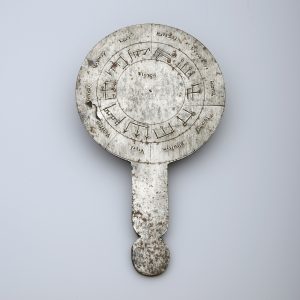
Magic mirror of Floron. Mathematisch-Physikalischer Salon, Staatliche Kunstsammlungen Dresden. Via Creative Commons.
Organizers
Sanne de Laat
English Department
Radboud University Nijmegen
László Sándor Chardonnens
English Department
Radboud University Nijmegen
The Netherlands
Presider
László Sándor Chardonnens
Presenters
Hélène Colleu (POLEN Lab, Université d’Orléans)
“Alia experimentum [sic] cristalli pro puero: Scrying in a 15th-century Nigromantic Manuscript”
David Porreca (Department of Classics, University of Waterloo)
“Medieval Magic: Solitary versus Collective Rituals in the Picatrix and the Munich Handbook”
Sanne de Laat
“Seeing the Whole Picture: Scryers and Their Networks in Medieval and Early Modern England”
Marla Segol (State University of New York at Buffalo)
“Scrying for Salvation: Ritual Innovation and Gender in 16th-Century Ottoman Kabbalah”
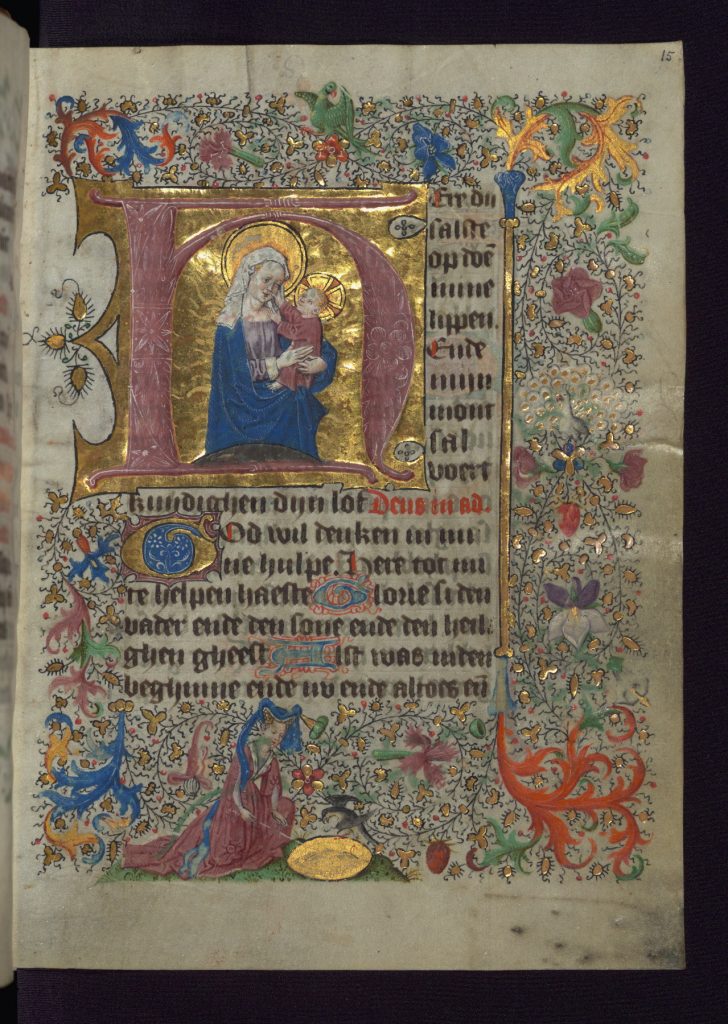
Baltimore, Walters MS W.782, folio 15r. Van Alphen Hours. Dutch Book of Hours made for a female patron in the mid 15th century. Opening page of the Hours of the Virgin: “Here du salste opdoen mine lippen”. At the bottom of the page, an elegantly dressed female figure gazes into a bowl- or mirror-like object, perhaps to perform skrying or to lure a unicorn. Image via Creative Commons.
[Note that the Business Meeting of the Societas Magica takes place in between these 2 Sessions, in a nearby room in the same building.
Starting at 11:45
Fetzer 1035]
5. Revealing the Unknown II:
Sortilège, Bibliomancy, and Divination [CANCELLED]
Saturday, 9 May
Session 396: 1:30–3:00 p.m.
Fetzer 2030
From earliest times, humans have sought methods to contact supernatural entities to obtain knowledge of the present or future, known as divination. In ancient and medieval contexts, two such methods that were sometimes connected were sortilege and bibliomancy: for example, the Lots of Mary, Sortes Astramphysychi, Homeric Oracles, and Virgilian Oracles.
These practices involved numerological processes to select specific passages from canonical texts in order to divine on desired topics. This session focuses on these and other methods of divination, so as to understand how textual and other authorities became invested with powers far greater than the impacts of their literary merits.
Organizer
Phillip A. Bernhardt-House (Skagit Valley College – Whitbey Island)
Presider
Phillip A. Bernhardt-House
Presenters
Laurence Erussard (English Department, Hobart and Smith Colleges, Geneva, New York)
“Divination: The Carving of Runes, and Their Relationship to Poetry in Icelandic Literature”
Carole A. Myscofski (Religion Department, Illinois Wesleyan University)
“Divining the Future in Sixteenth-Century Brazil: Texts and Pretexts”
Respondent
Michael A. Conrad (Kunsthistorisches Institut, University of Zurich)
“Unlocking the Future: Remarks on the Materiality of Tools of Sortilège (A Response)”
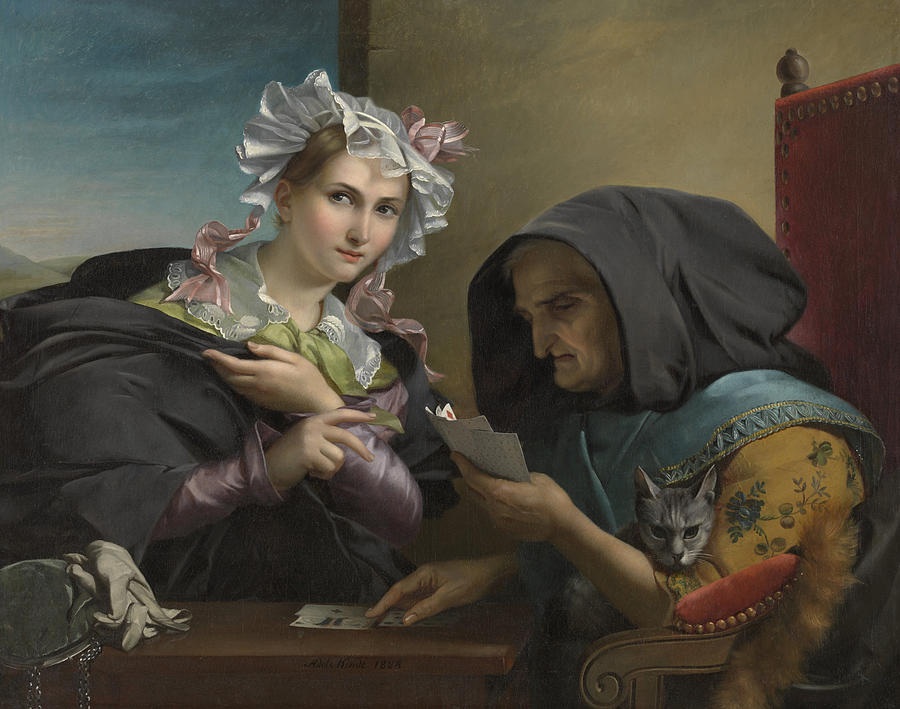
Adèle Kindt (1804–1884), The Fortune Teller (circa 1835), cat included. Antwerp, Koninklijk Museum voor Schone Kunsten. Image via Wikimedia Commons.
*****
Please Contact Us with your questions and suggestions.
For our nonprofit educational mission, with tax-exempt status, donations in funds and in kind (expertise, materials, time) are welcome. Join us!
*****
For updates, please visit this site, our News & Views, and our Facebook Page .

*****

